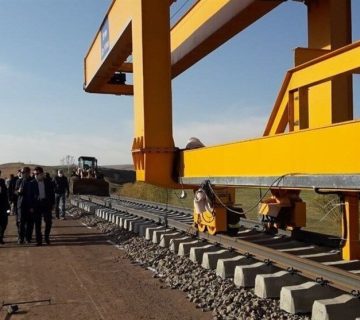The Iraqi Republic Railways Company and its Iranian counterpart signed a memorandum of understanding (MoU) on Sunday, outlining executive procedures for establishing a rail connection between the two countries.
The MoU was signed at the Iranian Consulate in Basra Province by the general director of the Iraqi Republic Railways Company and the executive director of the Iranian Railways Company, Shafaq News reported.
During their visit, officials from both countries inspected the border region for the project, following the maps approved by both sides. This included the Shalamcheh border region in southwestern Iran, the newly-established passenger station there, and the route under study from this border to the Arvand River on the Iranian side.
They also examined the banks of the aforementioned river and the central part of it, known as “Sindbad Island” in Iraq, specifically the location for the construction of the bridge and a new passenger station in Basra.
After six hours of negotiations, both parties agreed on the precise route for the railroad from Shalamcheh to the Arvand River and established a specific timeline for the executive operations of the rail connection between Shalamcheh and Basra.
This included scheduling operations for mine clearance and the construction of rail infrastructure from Shalamcheh to Arvand (Shatt al-Arab on the Iraqi side) and the handover of land for studies on the bridge’s supporting structures, which will connect the riverbanks.
Additionally, the Iraqi Republic Railways Company and its Iranian counterpart signed a map outlining the railroad’s route, which was accompanied by the MoU detailing the executive procedures for the rail connection between the two countries.
The Shatt al-Arab known as Arvand in Iran is a river extending over 200 kilometers that is formed at the confluence of the Euphrates and Tigris rivers in the town of al-Qurnah in the Basra Governorate of southern Iraq. The southern end of the river constitutes the Iran–Iraq border down to its mouth, where it discharges into the Persian Gulf. The Shatt al-Arab varies in width from about 232 meters at Basra to 800 meters at its mouth.
Iraq Allocates $230m to Project
Iran and Iraq agreed earlier to start the construction of the long-planned 32-km railroad from Shalamcheh in Iran to Basra in Iraq after the end of Ramadan on April 20, according to Iran’s deputy foreign minister for economic diplomacy, Mehdi Safari.
“Iraq has allocated a budget of nearly $230 million for the Shalamcheh-Basra railroad and this is happening for the first time,” Safari was quoted as saying by the International Railway Journal.
He was speaking after Iraq’s transport minister, Razzaq Muhibis Al-Saadawi, visited Tehran to finalize bilateral agreements and projects, including the cross-border railroad.
Al-Saadawi met with his Iranian counterpart, Mehrdad Bazrpash, who said that the first phase of construction will involve demining the border area that has remained inaccessible since the end of the Iran-Iraq War in 1988.
This would be followed by work to build an 880-meter moveable bridge across the Shatt Al-Arab River in Iraq, undertaken by Iranian contractors.
Tracklaying is due to start at the same time, with other infrastructure work to be undertaken by the Iraqi Republic Railways.
Iran to Build Bridge Over Border River
Iranian Foreign Ministry Spokesperson Nasser Kanaani recently announced Iran’s acceptance of bridge construction on the Shatt Al-Arab River linking it with Iraq, Iraqi News reported.
During a weekly press conference, Kanaani explained that the Iranian-Iraqi relations are favorable and witnessed many achievements.
“Iran accepted the construction of a bridge on the Shatt al-Arab River between Iran and Iraq,” he added.
The new railroad is expected to take 18 months to complete. Introducing a rail link between the two countries is forecast to provide a major stimulus for both passenger and freight traffic between Iran and Iraq, including religious tourism.
Connecting Shalamcheh and Basra will also complete a missing link in the region, potentially connecting Iran’s major rail network with Syria and Jordan via Iraq.
Hindrances
According to Al-Monitor, the Islamic Republic of Iran Railways revealed details of a plan to connect Basra with Shalamcheh in 2018. However, the Iraqi side has failed to build the railroad from Shalamcheh to Basra so far due to economic problems and a shortage of funds.
“For almost 20 years, we have had numerous negotiations with Iraq for the implementation of the Shalamcheh-Basra railroad, and there were even many agreements in different periods, which never reached the desired result,” said former Iranian roads minister, Qasem Rostami, after a visit to Iraq in late 2021.
In 2015, the then roads minister, Abbas Akhoundi, traveled to Abadan to start the extension of the railroad to the border, from Khorramshahr to Shalamcheh which is on the border with Iraq.
In order to complete the Shalamcheh-Basra railroad, the 17-kilometer Khorramshahr-Shalamcheh railroad was completed in 2011 to connect Iranian railroads to the Iraqi city of Basra.
The project is aimed at facilitating the travel of Iranian pilgrims, especially during the Arbaeen pilgrimage season and travelers could use this rail link from Iran via Basra to Karbala and other holy cities of Iraq.
While Iraqi passenger and freight trains are using the rail link of Basra to Karbala, Iranian pilgrims have been travelling by train from Tehran to Shalamcheh and from there after a 32-km trip by bus to Basra and depart from Basra to Karbala by Iraqi train.
Completion of East-West Corridor
The importance of this project, according to the CEO of the Islamic Republic of Iran Railways, Miad Salehi, is the completion of the wide east-west corridor.
“Our goal is to establish transit corridors and fix any deficiencies,” he said at the time of signing the joint cooperation agreement.
The Iranian authorities have always emphasized that completing the railroad will create an east-west rail transit corridor to the shores of the Mediterranean Sea, passing through Iraq to Syria reaching the port of Latakia. It can bring many benefits to the three countries.
Since Iraq is one of Iran’s largest economic partners, the connection could allow Iran to increase its trade with Iraq, Syria and Europe.
Today, Iran is connected to many surrounding countries, such as Russia, Turkey and Pakistan. The construction of Shalamcheh-Basra railroad will connect Iraq to all of Iran, as well as to Afghanistan, Pakistan, the Caucasus, Central Asia and the Far East. In addition, Iraq may in the future be on the transit route of goods between the south and the Arab countries of the Persian Gulf region with Central Asia and Russia.
According to Rostami, although the initial agreement was to have a 50% stake, Iran will take a larger share of the investment if the Iraqi side agrees. He stated that this connection is very important for Iran and Iraq both in terms of transit issues and passenger movement, especially in the Arbaeen, when millions of Shias travel to Iraq for visiting Imam Hussein (PBUH) holy shrine, and bilateral relations.





No comment